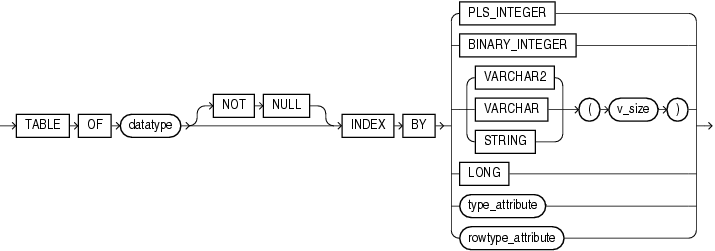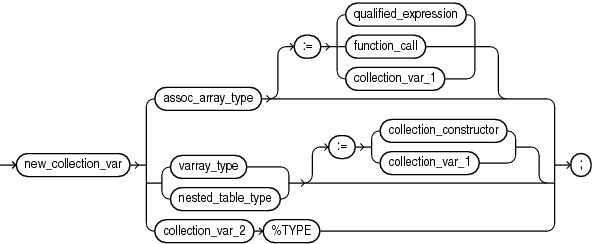13.11 Collection Variable Declaration
A collection variable is a composite variable whose internal components, called elements, have the same data type.
The value of a collection variable and the values of its elements can change.
You reference an entire collection by its name. You reference a collection element with the syntax collection(index).
PL/SQL has three kinds of collection types:
-
Associative array (formerly called PL/SQL table or index-by table)
-
Variable-size array (varray)
-
Nested table
An associative array can be indexed by either a string type or PLS_INTEGER. Varrays and nested tables are indexed by integers.
You can create a collection variable in either of these ways:
-
Define a collection type and then declare a variable of that type.
-
Use
%TYPEto declare a collection variable of the same type as a previously declared collection variable.
Note:
This topic applies to collection types that you define inside a PL/SQL block or package, which differ from standalone collection types that you create with the "CREATE TYPE Statement".
In a PL/SQL block or package, you can define all three collection types. With the CREATE TYPE statement, you can create nested table types and VARRAY types, but not associative array types.
Topics
Syntax
collection_type_definition ::=
assoc_array_type_def ::=
collection_variable_decl ::=
(collection_constructor ::=, function_call ::=, qualified_expression ::=)
Semantics
collection_type_definition
type
Name of the collection type that you are defining.
assoc_array_type_def
Type definition for an associative array.
Restriction on assoc_array_type_def
Can appear only in the declarative part of a block, subprogram, package specification, or package body.
datatype
Data type of the elements of the associative array. datatype can be any PL/SQL data type except REF CURSOR.
NOT NULL
Imposes the NOT NULL constraint on every element of the associative array. For information about this constraint, see "NOT NULL Constraint".
{ PLS_INTEGER | BINARY_INTEGER }
Specifies that the data type of the indexes of the associative array is PLS_INTEGER.
{ VARCHAR2 | VARCHAR | STRING } (v_size)
Specifies that the data type of the indexes of the associative array is VARCHAR2 (or its subtype VARCHAR or STRING) with length v_size.
You can populate an element of the associative array with a value of any type that can be converted to VARCHAR2 with the TO_CHAR function (described in Oracle Database SQL Language Reference).
Caution:
Associative arrays indexed by strings can be affected by National Language Support (NLS) parameters. For more information, see "NLS Parameter Values Affect Associative Arrays Indexed by String".
LONG
Specifies that the data type of the indexes of the associative array is LONG, which is equivalent to VARCHAR2(32760).
Note:
Oracle supports LONG only for backward compatibility with existing applications. For new applications, use VARCHAR2(32760).
type_attribute, rowtype_attribute
Specifies that the data type of the indexes of the associative array is a data type specified with either %ROWTYPE or %TYPE. This data type must represent either PLS_INTEGER, BINARY_INTEGER, or VARCHAR2(v_size).
varray_type_def
Type definition for a variable-size array.
size_limit
Maximum number of elements that the varray can have. size_limit must be an integer literal in the range from 1 through 2147483647.
datatype
Data type of the varray element. datatype can be any PL/SQL data type except REF CURSOR.
NOT NULL
Imposes the NOT NULL constraint on every element of the varray. For information about this constraint, see "NOT NULL Constraint".
nested_table_type_def
Type definition for a nested table.
datatype
Data type of the elements of the nested table. datatype can be any PL/SQL data type except REF CURSOR or NCLOB.
If datatype is a scalar type, then the nested table has a single column of that type, called COLUMN_VALUE.
If datatype is an ADT, then the columns of the nested table match the name and attributes of the ADT.
NOT NULL
Imposes the NOT NULL constraint on every element of the nested table. For information about this constraint, see "NOT NULL Constraint".
collection_variable_decl
new_collection_var
Name of the collection variable that you are declaring.
assoc_array_type
Name of a previously defined associative array type; the data type of new_collection_var.
varray_type
Name of a previously defined VARRAY type; the data type of new_collection_var.
nested_table_type
Name of a previously defined nested table type; the data type of new_collection_var.
collection_constructor
Collection constructor for the data type of new_collection_var, which provides the initial value of new_collection_var.
collection_var_1
Name of a previously declared collection variable of the same data type as new_collection_var, which provides the initial value of new_collection_var.
Note:
collection_var_1 and new_collection_var must have the same data type, not only elements of the same type.
collection_var_2
Name of a previously declared collection variable.
%TYPE
See "%TYPE Attribute".
Examples
-
Example 5-1, "Associative Array Indexed by String"
-
Example 5-2, "Function Returns Associative Array Indexed by PLS_INTEGER"
-
Example 5-4, "Varray (Variable-Size Array)"
-
Example 5-5, "Nested Table of Local Type"
-
Example 5-13, "Two-Dimensional Varray (Varray of Varrays)"
-
Example 5-14, "Nested Tables of Nested Tables and Varrays of Integers"
Related Topics
In this chapter:
In other chapters:




